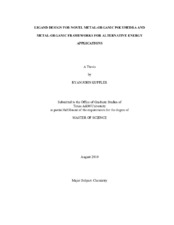| dc.description.abstract | The primary goal of this research concerns the synthesis of organic ligands in an effort
to create metal-organic porous materials for the storage of gas molecules for alternative
energy applications as well as other applications such as catalysis, molecular sensing,
selective gas adsorption and separation. Initially, the focus of this work was on the
synthesis of metal-organic polyhedra, yet the research has to date not progressed past the
synthesis of ligands and the theoretical polyhedron that may form. Further efforts to
obtain polyhedra from these ligands need to be explored.
Concurrently, the search for a metal-organic framework that hopefully breaks the
record for methane adsorption at low pressure and standard temperature was undertaken.
A framework, PCN-80, was synthesized based off a newly synthesized extended
bianthracene derivative, yet was unstable to the atmosphere. Hydrogen and methane
adsorption capacities have been evaluated by molecular simulations; these adsorption
isotherms indicated a gravimetric hydrogen uptake of 9.59 weight percent and a
volumetric uptake of methane of 78.47 g/L.
Following the synthesis of PCN-80, a comparison study involving the effect of the
stepwise growth of the number of aromatic rings in the ligand of a MOF was pursued;
the number of aromatic rings in the ligand was varied from one to eight while still
maintaining a linear, ditopic moiety. The synthesis of another bianthracene-based ligand
was used to complete the series of ligands and PCN-81, a two-dimensional framework
with no noticeable porosity as evident by the simulated hydrogen uptake of 0.68 weight
percent, was synthesized. All of these MOFs were synthesized from zinc salts to reduce
the number of variables. No clear relationship was established in terms of the number of
aromatic rings present in the ligand and the hydrogen adsorption capacity. However, it
was confirmed that the density and hydrogen uptake in weight percent are inversely
proportional. Further work needs to be done to determine what advantages are offered by
these novel frameworks containing extended bianthracene derivatives. For example, with
the highly fluorescent nature of the ligands from which they are composed, both PCN-80
and PCN-81 should be studied for the potential use in the application of fluorescent
materials. | en |


